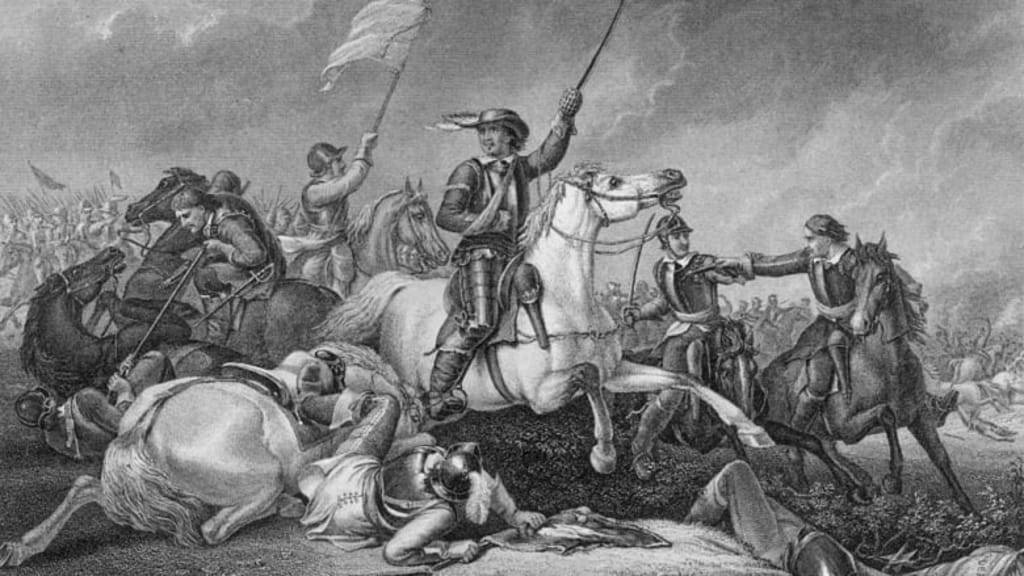The English Civil War in the 1640s pitted King Charles I against Parliament in a bitter struggle over the future of the monarchy and the country. After nearly three years of deadlock, the decisive Battle of Naseby in June 1645 marked a major turning point in the war and sealed the fate of King Charles.
The origins of the clash stretched back years before the actual outbreak of fighting. Tensions had risen between King Charles I and Parliament over issues of taxation, religion, and the limits of royal authority. Matters finally came to a head in 1642 when Charles raised his standard in Nottingham, formally declaring war on Parliament.
The early years of combat brought no clear victor. Stalemate ensued as both sides built their forces and fought inconclusive battles. By 1645, Parliament had created a new professional army, the so-called New Model Army, under Sir Thomas Fairfax and Oliver Cromwell. King Charles still commanded a formidable force of veteran Royalist troops. The stage was set for a showdown.
On the morning of June 14, 1645, the two armies faced off near the village of Naseby in Northamptonshire. The Royalists occupied the high ground on Dust Hill about a mile north of Naseby village. Parliament's New Model Army assembled atop the opposing Naseby Ridge. After some initial manoeuvring, the main battle commenced around 10 am.
Parliament struck first, sending a contingent of dragoons to provoke an attack on the Royalist right flank. The ploy worked. Royalist cavalry under Prince Rupert charged forward but were drawn into a clever ambush and flanking fire from the dragoons hiding in the Sulby hedges. Half of the Parliamentary cavalry fell back in the chaos, opening a gap in their lines. Sensing an opportunity, Rupert rallied his infantry into a massive pike formation over half a mile wide and pressed the attack.
Intense close-quarters fighting ensued as the pike formations clashed. The Royalist infantry gradually gained the upper hand and pushed back the Parliamentary centre. But just as the battle seemed to swing in the King's favour, Oliver Cromwell and his remaining cavalry smashed into the Royalist horse on the left flank. Cromwell then wheeled to attack the Royalist infantry, pinning it from both sides. Beset from all directions, the Royalist foot soldiers finally broke and retreated.
The battle rapidly turned into a rout as Parliament's cavalry pursued and cut down the fleeing Royalists. King Charles managed to escape with a handful of followers, but he had lost over three-quarters of his army, either to death or capture. It was a devastating blow from which he would never recover.
The carnage at Naseby highlighted the brutal nature of 17th century warfare. The flintlock muskets and crude mortars used caused horrific injuries. Battlefield surgery by so-called barber-surgeons to remove bullets and amputate limbs was primitive and agonizing. Most men were simply left to die.
The iconic weapons of pike and shot epitomized the English Civil War. Pike formations up to 18 feet long defended musketeers from cavalry. Huge mortars like "Roaring Meg" battered town defences. Cavalry clashes often devolved into bloody hand-to-hand combat with sword and dagger.
Naseby determined the eventual outcome of the war. The destruction of the main Royalist field army crippled King Charles. Subsequent sieges mopped up the remaining isolated pockets of Royalist resistance. Charles tried to rally support but was eventually captured, tried, and executed as a traitor in 1649. His defeat at Naseby sealed his fate.
The Parliamentary victory also paved the way for Oliver Cromwell's ascendancy. With the New Model Army behind him, Cromwell ruled England as Lord Protector until his death in 1658. The bloody internecine conflict left a deep legacy of division within England that took generations to heal. But Parliament's triumph at Naseby set the course for the future evolution of British constitutional monarchy and parliamentary democracy.



No comments yet
Be the first to share your thoughts!